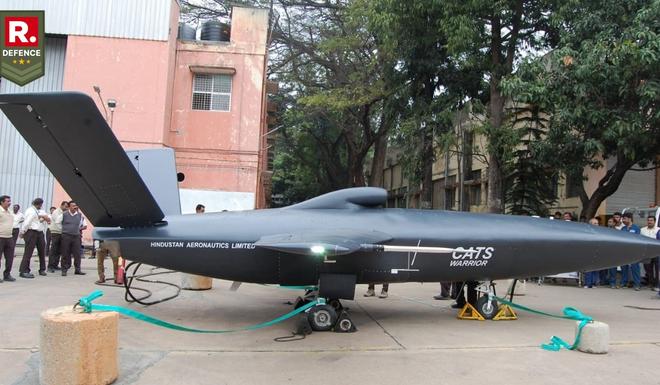Published 15:50 IST, January 22nd 2025
HAL’s CATS Warrior Quietly Achieves Major Milestone with Successful Engine Ground Run
HAL achieved a significant milestone in its Combat Air Teaming System program with the successful completion of the Engine Ground Run of the CATS Warrior.

Bengaluru, India – Hindustan Aeronautics Limited (HAL) has achieved a significant breakthrough in its flagship Combat Air Teaming System (CATS) program with the successful completion of the Engine Ground Run of the full-scale demonstrator, CATS Warrior. This milestone marks a major step forward in India’s ambitious drive towards achieving self-reliance in unmanned and manned combat teaming systems, reinforcing the nation’s pursuit of next-generation aerial warfare capabilities.
The CATS Warrior, an Indigenous unmanned combat aerial vehicle (UCAV), is being developed under a Public-Private Partnership (PPP) between HAL and NewSpace Research & Technologies (NRT), an emerging Indian private defence startup. The project, which involves multiple stakeholders such as the National Aerospace Laboratories (NAL), Defence Research and Development Organisation (DRDO), and HAL’s Aircraft Research and Design Centre (ARDC), represents a concerted effort towards developing futuristic air combat solutions under the ‘Aatmanirbhar Bharat’ initiative.
Aerial Mothership Concept
The CATS Warrior system envisions a twin-seat HAL Tejas fighter jet serving as a ‘mothership,’ controlling a swarm of Unmanned Aerial Vehicles (UAVs) and Unmanned Combat Aerial Vehicles (UCAVs). These autonomous units, acting as force multipliers, will be capable of executing high-risk missions such as:
- Deep penetration precision strikes from stand-off distances
- High-altitude surveillance operations using atmospheric satellite technology
- Suppression of enemy air defences (SEAD) and electronic warfare support
- Decoy and swarm tactics to overwhelm adversary air defence systems
According to HAL, the CATS Warrior system is designed to minimize human exposure in high-threat environments while enhancing India’s air superiority through rapid, autonomous, and precise aerial strikes.
Indigenous Innovations Powering CATS Warrior
The successful engine run test highlights the remarkable synergy between various HAL research divisions. The Aircraft Research and Design Centre (ARDC) has led the design and integration efforts, while the Strategic Electronics Research and Development Centre (SLRDC) has provided an indigenous Mission Computer. Additionally, the project is powered by an indigenous powerplant developed by HAL’s Aerospace Engine Research and Development Centre (AERDC).

The prototype is expected to be officially unveiled at Aero India 2025, showcasing HAL’s advancements in cutting-edge air combat technology. The company aims to complete all developmental work by 2024 or 2025, aligning with India’s future air force requirements.
Design and Combat Capabilities
The HAL CATS Warrior is designed as a low-observable (stealth) UCAV, drawing inspiration from leading Western designs such as the MQ-28 Ghost Bat and the XQ-58 Valkyrie. Its notable design elements include:
- Hybrid airframe design, featuring stealth characteristics and radar-evading materials
- Internal weapon bays, enhancing its stealth profile
- A single serpentine air intake, minimizing radar signature and heat signature
- Payload versatility, capable of carrying:
- Two new-generation short-range or beyond-visual-range air-to-air missiles (AAMs)
- Two DRDO Smart Anti-Airfield Weapons (SAAW) for ground attacks
By integrating such advanced capabilities, the CATS Warrior will serve as a ‘loyal wingman’ to manned fighter jets, effectively supporting complex missions with minimal risk to human pilots.
Strategic Implications and Future Prospects
With global defence forces increasingly relying on autonomous aerial combat systems, HAL’s progress with the CATS Warrior underscores India’s commitment to bolstering its air power. Currently, only a handful of countries—including the US, China, and Russia—have ventured into similar unmanned teaming concepts. The successful implementation of CATS could elevate India’s standing in the global defence ecosystem and reduce dependence on foreign technologies.

Given the growing complexities of modern warfare, where unmanned systems play an essential role in intelligence gathering and combat operations, the CATS Warrior program is expected to provide the Indian Air Force (IAF) with unprecedented force-multiplying capabilities, enhancing operational efficiency in contested environments.
As HAL continues to fine-tune the platform, the successful ground run signals a promising future for India’s Indigenous defence sector. The upcoming unveiling at Aero India 2025 is anticipated to generate significant interest from domestic and international stakeholders alike.
Updated 15:50 IST, January 22nd 2025



